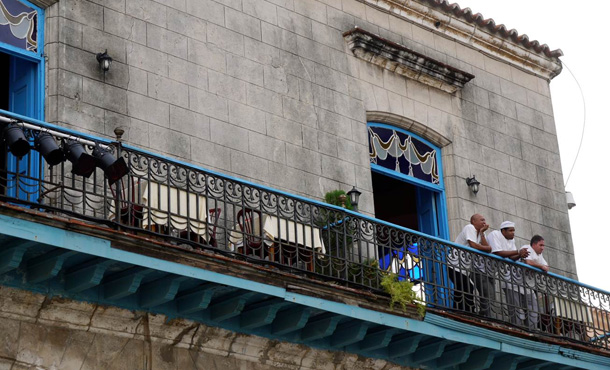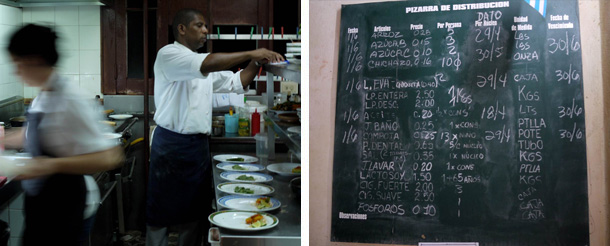Financial Times - More than just rice and beans
November 20, 2010

It is easy to find one of Havana’s many ration shops. The aged shuttered doors are folded back to the wall, the room is poorly lit and there is little for sale.
Just down from Plaza Vieja, in the historic district, I entered Bodega La Caridad. The shelves were mostly empty save for some small bags of raw and refined sugar, cooking oil in a reused plastic water bottle, a stack of cigarette packets and boxes of matches. On the wall was a chalkboard listing foodstuffs, the state-subsidised price and entitlement per person. A month’s ration of rice (3kg), for example, costs less than the equivalent of five pence but many products were unavailable.
An elderly couple – she gnarled like ginger, he shirtless with an operation scar across his stomach – stood in front of the counter. The saleswoman poured rice from a sack before marking down the purchase in their ration book, a small dog-eared jotter.
Around the corner, I had just eaten lunch at El Templete, where the new chef, Jose Carlos Castillo Valderrama, had recently arrived from Andalusia. “Like everyone, I thought Cuban cuisine was little more than rice and beans,” he said. “But there are Arabic and Mediterranean influences from Spain, as well as Creole and indigenous dishes that use root vegetables, maize and plantain.”
The menu was spot-on: fish croquettes, golden and crisp with a delicate herby mash inside; tiny mouthfuls of quick-fried calamari; grilled red snapper falling away in perfect flakes under my fork, in a light salsa verde with pimientos. It was a long way from the shop around the corner. “If you can pay, you can get most things,” Castillo Valderrama said.
For ordinary Cubans, food shortages have helped kill off the joy of cooking, particularly in the home. Several people told me they had given up caring about the taste of what they eat. “The fruit is ugly, the vegetables dirty and the meat is covered in flies,” one taxi driver said. “You need to spend six months here to understand the situation, not a few days.”
“I’m writing about potatoes, not politics,” I replied defensively.
“That’s the point,” he shouted back. “There are no potatoes.”
At the market close to my hotel, vendors had little more to sell than a half-dozen stunted pineapples, a box of garlic and sack of green peppers. A journey out of Havana through farmland proves how paltry production has become. The land recalls a chapter from The Grapes of Wrath: farmers cane skinny oxen to plough dusty fields; the barns seem to wilt; on the front porches, men and women, shrivelled and dry like tobacco leaves, stare out at the odd passing car (or, more often, horse and trap). Unofficial estimates suggest as much as 80 per cent of Cuba’s food is now imported.
Unlike El Templete, which is an unusual public-private joint venture, most restaurants are run by the state with unmotivated staff serving up miserable food. But a mixture of frustration and true-grit vision is firing up some individuals, such as Enrique Nuñez, the restaurateur behind the acclaimed La Guarida. “It’s true Cubans have stopped creating new recipes,” he said. “On a basic level, they cannot get hold of ingredients but they also have no idea what’s happening in gastronomy in the rest of the world.”
La Guarida is almost as tough to find as it was to dream up. Nuñez had put up a sign since I was last there because so many tourists had got lost. Outside, the streets look as if they have been shelled. Kids were playing in the gaping holes while up on the buckled road their brothers practised baseball with sticks for bats. Men were bent under bonnets fixing the 50-year old engines of Buicks. Up on balconies, elderly women surveyed the street from between lines of laundry, plant pots and drooping cables.
I climbed the stairs to the second floor, past a quartet of men playing dominoes in a hallway, and pressed the buzzer of a nondescript door. On the other side, La Guarida’s four candle-lit rooms were abuzz with tourists eating signature dishes such as aubergine caviar with tomato coulis. The aubergine was gently mashed, giving it a consistency that did almost echo fish eggs – an example of how chefs have coped with limited resources. The slender snapper carpaccio was offset by the fresh crunch of coriander and drenched in lime juice. It tasted of lazy Caribbean days.
La Guarida is one of a host of paladares, or family-run restaurants, a concept invented in the mid-1990s after the Soviet Union collapsed and the Cuban economy went into freefall. Food was so scarce then that rations included vitamin tablets to supplement the poor diet. Former president Fidel Castro reluctantly opened up the island to tourism and issued licenses to allow ordinary Cubans to offer meals to tourists – with restrictions. Only 12 seats were allowed. Shellfish and beef were banned from the menu. All the staff had to be family. Toughest of all, taxes were high and had to be paid in advance. But some say the rules boosted creativity, elevating paladares to easily the best places to eat in Cuba.
My finest meal was at stylish La Esperanza in upscale Miramar. Service was no-nonsense, even curt, but the paperless menu was patiently explained and the food formidable. The red snapper escabèche was better than ceviche, similarly marinated in olive oil, vinegar, lemon juice and salt but using fish that was cooked instead of raw. Calamari was stewed in a pepper sauce with soft white rice. The flan was exactly the right weight, dense with caramel but light enough to love. Their mojitos, like all mojitos in Cuba, had a woody stem of mint rather than a meagre few leaves in the glass. It was joyful food, the kind that makes you want to salsa. Appropriately, the name of this paladar means hope.
More down-home, La Casa was less ambitious but equally good. Slices of smoked pork loin were so deeply marinated they melted in my mouth like Swiss chocolate. A small bowl of black beans was drizzled in aged rum. Francisco Briñis, whose aunt founded the restaurant, rolled his eyes when I asked about the challenge of sourcing food. “Let’s say it’s no harder than at the beginning,” he tells me. “We decided to keep the menu unfussy – chicken, pork and fish in simple sauces – to make finding ingredients easier.”
If only Havana had more inspired restaurants such as these but the government has not issued a new paladar license in more than a decade. The future looks more likely to be found in joint ventures such as El Templete.
There is, of course, always the possibility of greater change. A thaw in relations with the US, and an influx of American tourists, would certainly have an impact on life here.
“We don’t want to be another Puerto Rico, though,” one 28-year-old told me. “Most of us believe in some kind of hybrid economy. The thing is I don’t want to die waiting for change, like my father did.”
“Vamos a ver” (We’ll see) is the refrain here. Until then, Cuban cuisine deserves to graduate from the stereotype that has dogged it: rice and beans or beans and rice as the only two choices on the menu. Tucked away in families’ front rooms, the paladares are worth seeking out. They deserve our custom. They deserve a medal.

Home cooking: The best places to eat in Havana
El Templete
Located by the port this venture binds a pioneering business model with a progressive kitchen, where seafood is often sourced directly from fishermen’s boats.
12-14 Avenida del Puerta, corner Narciso López, Habana Vieja.
La Guarida
Reserve a table in advance at Havana’s most celebrated restaurant, as betrayed by signed celebrity photographs on the walls. The spinach crêpes are the hot new dish.
Calle Concordia 418, between Gervasio and Escobar, Centro Habana.
La Esperanza
Chickens scratch in the dust in the front yard of this ivy-clad house, perhaps a clue as to how fresh the pollo was. Overlook the dour service and focus on the stylish eclectic decor and committed creative cuisine.
105 calle 16, between 1ra and 3ra, Miramar
La Casa
Just beyond the Plaza del Revolución, this is home-cooked food any grandmother would be proud of. The cerdo ahumado (smoked pork) is a Cuban classic and nowhere does it better.
865 calle 30, between 26 and 41, Nuevo Vedado.
La Cocina de Lilliam
Consistently good food, including Creole dishes such as tamal en cazuela (sweet maize soup) and garbanzos fritos (fried chickpeas).
1311 calle 48, between 13 and 15, Playa.
La Fontana
A Japanese chef serves sashimi by night but closer-to-home dishes have the edge, like classic ceviche and tomato stuffed with crab.
A305 calle 3ra, corner of 46, Miramar.
La Bacura
At Playas del Este, this place offers home-style cooking: mariquitas (fried plantain chips), chilindrón de cordero (stewed lamb) and yuca con mojo (shredded yucca in pork fat).
7 calle San Juan, corner of Carlos and Santa Marta, Celimar.




